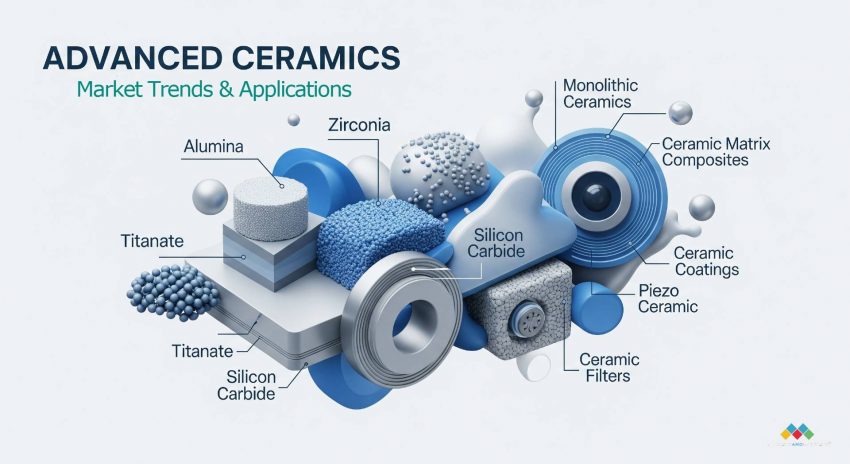The Advanced Ceramics Market is undergoing dynamic transformation, fueled by growing demand for robust, lightweight, and corrosion-resistant materials across various sectors. With unmatched mechanical strength, thermal stability, and electrical insulation properties, advanced ceramics are no longer niche materials—they’re now essential components in modern engineering, electronics, healthcare, and clean energy technologies.
What Sets Advanced Ceramics Apart?
Unlike conventional ceramics used in household items or construction, advanced ceramics—often referred to as technical ceramics or high-performance ceramics—are manufactured using highly purified raw materials and specialized processes. These materials are engineered for applications requiring superior performance under extreme conditions.
Common materials used in advanced ceramics include:
- Alumina (Al₂O₃): Known for hardness, thermal conductivity, and chemical resistance
- Zirconia (ZrO₂): Biocompatible and strong, widely used in medical implants
- Silicon Carbide (SiC): Ideal for high-temperature and power electronic applications
- Silicon Nitride (Si₃N₄): Excellent for high-stress mechanical systems
- Ceramic Matrix Composites (CMCs): Lightweight and durable alternatives to metals in aerospace and defense
Key Industry Applications and Market Trends
1. Electronics & Semiconductors
The rapid evolution of electronics and the growth of high-speed communication networks have led to increased use of ceramics in circuit boards, capacitors, substrates, and insulators. Materials like alumina and silicon nitride enable better heat dissipation and long-term reliability in compact, high-performance devices.
2. Aerospace & Defense
Ceramic matrix composites are gaining popularity in aircraft engines, thermal barriers, and armor systems. These materials not only reduce weight but also resist heat and mechanical stress, making them ideal for mission-critical aerospace and defense components.
3. Medical & Healthcare
Bioceramics such as zirconia and hydroxyapatite are revolutionizing orthopedics and dentistry. Used in implants, prosthetics, and bone grafts, these materials offer excellent integration with human tissue, minimal wear, and long-term durability.
4. Automotive & Electric Vehicles
The transition to electric mobility is creating new opportunities for ceramics in EV batteries, power modules, braking systems, and thermal insulation. Silicon carbide ceramics, for example, help enhance energy efficiency, improve range, and reduce component size.
5. Renewable Energy & Environmental Systems
Advanced ceramics are critical to the performance and longevity of solid oxide fuel cells (SOFCs), solar modules, and water filtration systems. Their resistance to chemicals, temperature fluctuations, and wear makes them ideal for sustainable energy technologies.
Regional Market Overview
- Asia-Pacific remains the dominant region, with countries like China, Japan, and South Korea investing heavily in electronics, automotive, and industrial ceramics manufacturing.
- North America is leading in innovation, especially in aerospace, medical, and defense-related ceramic applications.
- Europe continues to advance in environmental applications and energy-efficient ceramic components, especially for the automotive and energy sectors.
What’s Driving Market Growth?
Several key factors are contributing to the expansion of the advanced ceramics market, including:
- Rising demand for high-performance, wear-resistant, and lightweight materials
- Acceleration in 5G infrastructure and compact electronic systems
- Expansion of the electric vehicle market and clean energy systems
- Increased use of ceramic implants and prosthetics in healthcare
- Regulatory push for sustainable, long-lasting materials in industrial processes
Challenges to Watch
Despite its growth potential, the market faces challenges such as:
- High manufacturing and material costs
- Complexity in processing and quality control
- Limited scalability of certain advanced ceramics for mass production
However, recent advances in additive manufacturing and eco-friendly production techniques are reducing costs and opening doors for wider commercial adoption.
Future Outlook: Where the Market Is Headed
As R&D in nanostructured ceramics, ceramic coatings, and multi-functional composites continues to mature, the global advanced ceramics market is expected to reach new heights. Emerging areas such as wearable electronics, hydrogen fuel cells, and aerospace propulsion systems will increasingly rely on ceramics that outperform traditional metals and polymers.
From enabling next-gen electronics to supporting life-saving medical implants and clean energy solutions, advanced ceramics are setting the stage for the future of material science. As industries shift towards more sustainable, high-performance materials, the demand for advanced ceramics will remain strong—positioning this market as a cornerstone of industrial innovation for decades to come.

